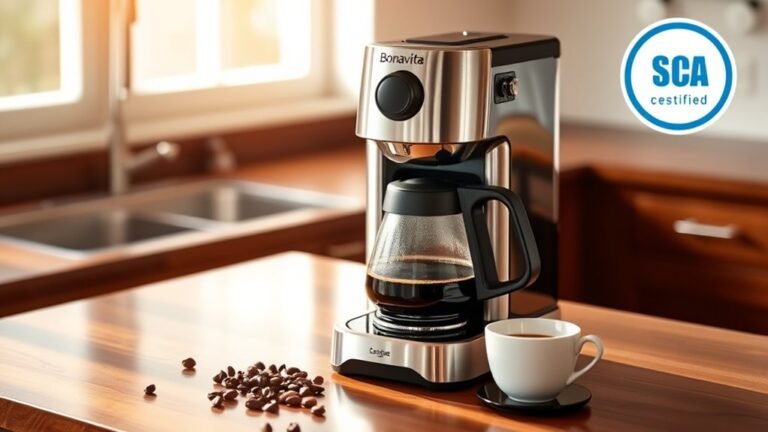The Different Types of Coffee Grinders: Burr vs. Blade
You’ll find two main coffee grinder types: burr and blade. Burr grinders crush beans between two abrasive surfaces, offering precise, uniform particle sizing that’s ideal for consistent extraction and flavor control. Blade grinders use spinning blades to chop beans unevenly, which works for coarser methods but compromises grind consistency. Burrs also reduce heat and static buildup, preserving integrity. If you want detailed insight on matching grinders to your brewing preferences, there’s more to explore ahead.
How Burr Grinders Work

Although burr grinders might seem complex, their operation is straightforward once you understand the mechanics: they use two abrasive surfaces—called burrs—that crush coffee beans into uniform particles by grinding them between a stationary burr and a rotating one. You control the distance between these burrs, directly affecting grind size consistency, essential for brewing precision. Burr grinder mechanics rely on this adjustable gap, allowing you to tailor grind coarseness for different brewing methods. Unlike other grinders, burrs create uniform particle sizes, minimizing over-extraction and under-extraction risks. This precision grants you freedom to experiment with grind settings, revealing diverse coffee flavors. Understanding burr grinder mechanics empowers you to achieve consistent results every time, ensuring your coffee’s taste is never compromised due to uneven grinding.
How Blade Grinders Work
Blade grinders operate using one or two rapidly spinning blades that chop coffee beans into smaller fragments. When you activate the grinder, the motor powers these blades at high speeds, pulverizing the beans through impact and shearing forces. This process results in uneven particle sizes, as the blades don’t consistently crush the beans but slice and dice them randomly. Understanding how blade grinders operate helps you anticipate the grind’s variability and adjust your technique accordingly. For peak performance, blade grinder maintenance is essential—regularly clean the chamber to prevent residue buildup and verify the blades remain sharp. By mastering these aspects, you retain control over your grind quality while embracing the freedom to experiment with different coffee textures.
Advantages of Burr Grinders
Burr grinders offer a significant advantage in grind consistency by crushing coffee beans between two abrasive surfaces, allowing you to achieve uniform particle size tailored to your brewing method. This precision directly enhances flavor extraction, ensuring each cup reflects the coffee’s full potential. You gain control over grind size, which is essential for espresso, drip, or French press.
Key advantages include:
- Precise grind adjustments for consistent particle distribution
- Reduced heat generation preserving bean integrity
- Minimized static and clumping for even extraction
- Durable design ensuring long-term performance and reliability
With a burr grinder, you empower yourself to reveal nuanced flavors and maintain repeatable quality, giving you the freedom to experiment and perfect your brew.
Advantages of Blade Grinders

While burr grinders excel in precision and consistency, you might find blade grinders offer advantages that suit different needs or budgets. Blade grinders are highly cost effective, making them accessible if you want to avoid a significant upfront investment. Their simple design means fewer parts, reducing the risk of mechanical failure and lowering maintenance demands. You’ll appreciate the ease of use—they operate like a small blender: just pulse until you reach your desired grind size. This straightforward operation requires minimal learning, granting you freedom from complex settings or calibration. Although they sacrifice uniformity, blade grinders still deliver sufficient grind quality for many brewing methods, especially if you prioritize convenience and budget. Choosing one can free you from constraints while still providing freshly ground coffee.
Choosing the Right Grinder for Your Brewing Method
Since grind size directly affects extraction and flavor, selecting the right grinder for your brewing method is essential. You’ll want to prioritize grinder compatibility with your brewing preferences to reveal the best cup quality. Burr grinders excel with precision and consistency, fitting well with methods demanding uniform particle size, like espresso or pour-over. Blade grinders may suffice for coarser techniques such as French press but lack consistency for fine grinds.
Choosing a grinder that matches your brewing style ensures optimal extraction and flavor in every cup.
Consider these factors when choosing your grinder:
- Required grind size range for your preferred brew
- Consistency and uniformity of grind particles
- Capacity to adjust grind settings precisely
- Durability and maintenance aligned with your usage frequency
Frequently Asked Questions
Can I Use a Coffee Grinder for Spices?
You can use a coffee grinder for spices, but keep in mind the spice grinder benefits like enhanced flavor release and consistent texture. Coffee grinders, especially burr types, offer grinder versatility, allowing you to control grind size precisely. However, cross-contamination of flavors might occur, so thorough cleaning is essential. If you value freedom in your kitchen tools, a dedicated spice grinder or a versatile grinder that handles both coffee and spices efficiently is ideal.
How Often Should I Clean My Coffee Grinder?
Like tending a well-oiled machine, your grinder maintenance guarantees peak performance and flavor clarity. You should clean your coffee grinder every one to two weeks to prevent oil buildup and residual coffee grounds from affecting taste. For heavy daily use, consider cleaning more frequently. Disassemble removable parts, brush out debris, and wipe surfaces carefully. Regular cleaning frequency preserves your freedom to enjoy fresh, untainted coffee with every grind.
Are Manual Grinders Better Than Electric Ones?
You’ll find manual grinder advantages include precise control over grind size and no need for electricity, giving you freedom anywhere. They’re quieter, more portable, and often more durable. However, electric grinder convenience can’t be beaten when you want speed and ease, especially for larger quantities. If you value hands-on control and portability, manual’s better; but if you prioritize quick, consistent grinding with minimal effort, electric’s your go-to.
Do Grinders Affect Coffee Flavor Over Time?
You’ll notice that grinder longevity directly impacts flavor preservation. As your grinder wears down, its ability to produce uniform grounds diminishes, causing inconsistent extraction and off-flavors. Maintaining sharp burrs or blades guarantees consistent particle size, essential for peak flavor. Regular cleaning and timely replacement of parts help your grinder perform reliably over time, allowing you to enjoy fresh, balanced coffee without sacrificing the freedom to experiment with different beans and grind settings.
Can I Grind Coffee Directly Into a French Press?
Oh, sure, just toss your beans directly into the French press and expect a barista-worthy brew—because who needs precision? In reality, French press grinding demands a coarse, uniform coffee grind size to avoid sludge and over-extraction. Grinding straight into the press risks uneven particles, ruining flavor balance. To truly savor freedom in your cup, grind separately with a burr grinder, then gently add grounds to your French press for ideal extraction control.






